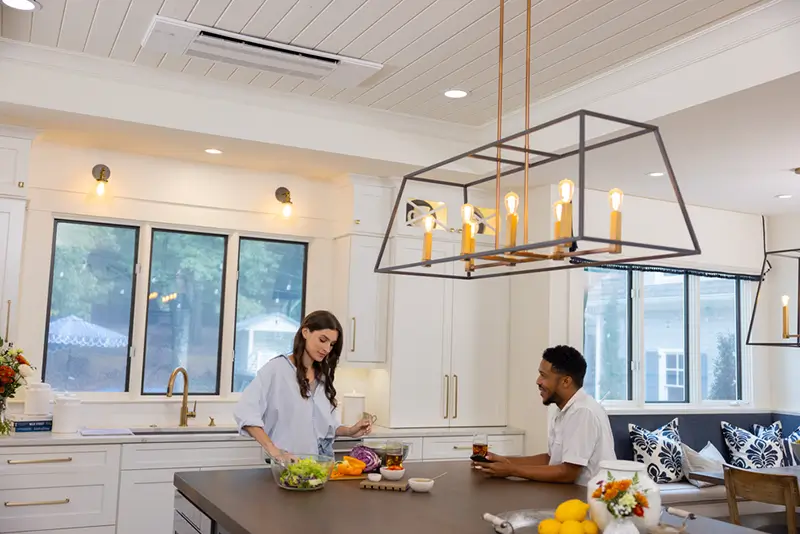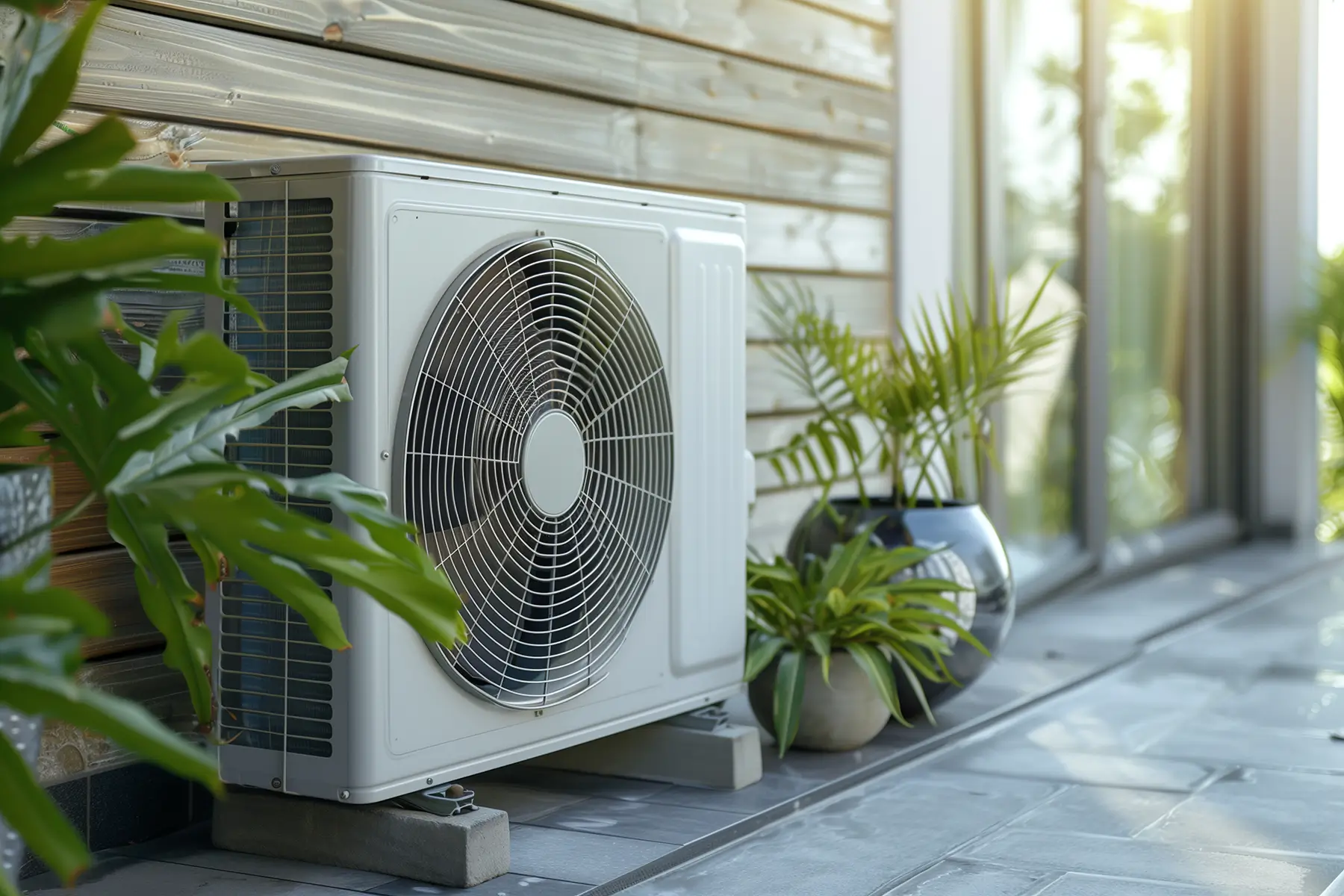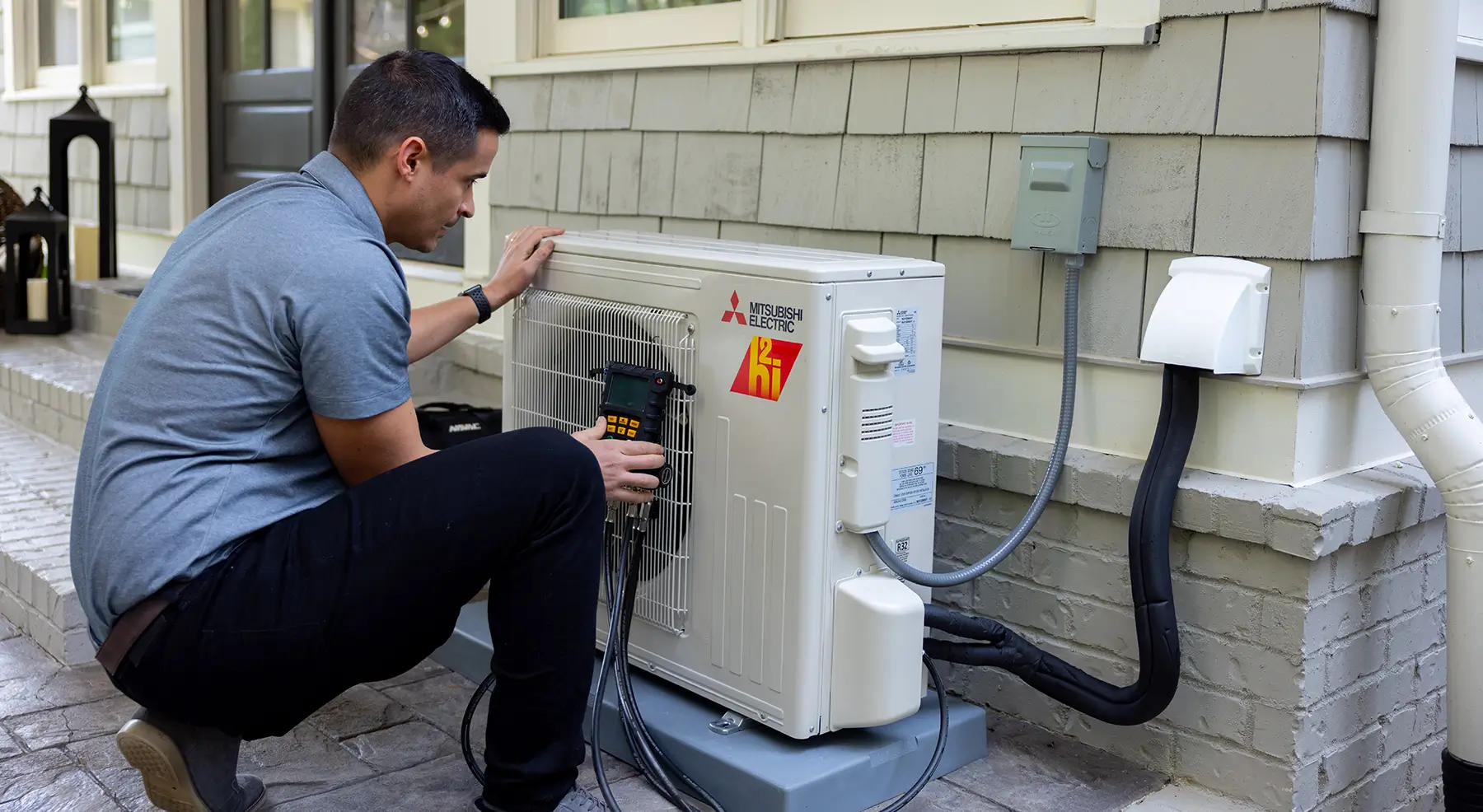Table of Contents
Integrating Mini-Splits into Your Home Aesthetic
Mini-split systems, recognized for their efficiency and flexibility, have emerged as a popular solution for heating and cooling modern homes. These ductless units offer significant installation and operational efficiency advantages but present unique challenges regarding home design. The key lies in discreetly blending these units into the existing decor or boldly making them a part of the home’s aesthetic statement.
Camouflaging Your Mini-Split
Strategic Placement and Camouflage: The most straightforward approach to minimizing the visual impact of your mini-split is to paint it the same color as the wall it’s mounted on, allowing it to recede into the background. For those preferring more decorative solutions, market-available or DIY covers that resemble artworks or architectural elements can offer an elegant disguise. Incorporating the unit into a false ceiling or a custom-built piece of furniture not only hides the unit but can also add to the room’s functionality and design.
Room Layout: Clever furniture arrangement and decor can divert attention from the mini-split. Tall plants, bookcases, or room dividers placed in strategic locations can help obscure the unit from view, although care should be taken not to obstruct airflow.

Highlighting Your Mini-Split
Making a Feature: For those who prefer to highlight their mini-split, selecting units with a distinctive look or incorporating lighting to accentuate the unit can transform it into your room’s modern, stylish feature. Creative enclosures or frames complementing the room’s decor can also showcase the unit, turning a functional necessity into a design asset.
Artistic Integration: Collaborating with artists to create custom covers or integrating the unit into a thematic design can make the mini-split a deliberate part of your home’s aesthetic. This approach allows the unit to stand out as a bold statement piece, contributing to the overall ambiance of the space.
Practical Considerations
Functionality should never be compromised when hiding or highlighting your mini-split. Ensuring adequate airflow and maintaining easy access for maintenance are paramount. Before undertaking any modifications, consulting with a professional installer can provide valuable insights into the feasibility and impact on your system’s efficiency.
Understanding Mini-Splits: Aesthetic and Functional Harmony
While primarily chosen for their functionality, Mini-split systems offer a canvas for aesthetic creativity within home design. As ductless units, they provide significant flexibility in placement and design integration, unlike traditional HVAC systems. This section delves into balancing the aesthetic integration of mini-splits with their operational efficacy, ensuring that design choices enhance these systems’ look and performance.
Strategic Camouflage Techniques
Paint and Color Matching: One of the simplest yet most effective strategies is painting the mini-split to match the surrounding walls. This approach requires minimal investment but can significantly reduce the unit’s visual impact, allowing it to blend with the wall seamlessly. When choosing paint, consider the unit’s material and the type that adheres well, ensuring longevity and ease of maintenance.
Decorative Covers: The market offers a variety of decorative covers that can encase mini-splits, ranging from minimalist designs to elaborate artistic creations. These covers can disguise the unit as a piece of art or a functional decor element, such as a shelf or cabinet. For those inclined towards unique solutions, DIY covers provide an opportunity to personalize the appearance of your mini-split, tailoring its look to match your interior design perfectly.
Integrating into Design Elements
Custom Shelving and Cabinets: Building a custom shelving unit or cabinet around your mini-split conceals it and adds valuable storage space or display areas to your room. This solution requires careful planning to ensure that the unit remains accessible for maintenance and that airflow is not obstructed.
False Ceilings and Walls: Incorporating mini-splits into false ceilings or walls is a more involved but highly effective method of hiding the unit. This approach can be particularly appealing in modern or minimalist interiors, where the seamless look is paramount. It’s crucial to consult with professionals to ensure that this integration is maintained for the system’s efficiency and your ability to access the unit for servicing.
Strategic Placement
Selecting the right location for your mini-split can inherently reduce its visual presence. Installing the unit in a less conspicuous part of the room or where the room’s architecture naturally obscures it can make it less of a focal point. However, it’s important to balance aesthetic considerations with the practical aspects of air circulation and cooling efficiency.
In summary, integrating mini-splits into home interiors requires a careful balance between aesthetics and functionality. By employing strategic camouflage techniques, integrating units into design elements, and considering the placement carefully, homeowners can achieve a harmonious blend that enhances the comfort and beauty of their living spaces.
Highlighting Your Mini-Split: A Design Feature
For those embracing the presence of their mini-split systems, there are innovative ways to transform these functional devices into eye-catching elements of interior design. Highlighting a mini-split involves creative approaches that make the unit visible and visually appealing, turning what could be seen as a necessity into a statement piece.
Making a Statement with Design
Selecting Stylish Units: Today’s market offers mini-split systems in various designs, from sleek, contemporary models to those with unique textures and colors. Choosing a unit that either contrasts with your wall color for a bold statement or complements your interior design theme can turn the system into a deliberate part of your decor.
Accent Lighting: Illuminating a mini-split with LED strips or spotlighting can elevate its presence in a room, casting it in a literal and figurative light. This approach works well in modern or tech-inspired themes, where the unit becomes part of the room’s futuristic feel.
Thematic Integration
Room Themes: Incorporating the mini-split into the theme can be a creative challenge. For instance, in a room with an industrial chic theme, the visible parts of a mini-split system can be embraced as part of the industrial aesthetic, complemented by metal accents and rustic elements.
Artistic Enclosures: Custom-made artistic enclosures can transform your mini-split into a unique art piece. Whether it’s a commissioned artwork that frames the unit or a thematic cover that reflects your style or hobbies, such artistic interventions can make the mini-split a focal point of discussions.
Artistic Covers and Enclosures
Going beyond functionality, some homeowners commission artists or utilize bespoke designs to create covers that are true works of art. These can range from painted canvases that camouflage the unit into a larger mural to sculptural elements that frame the unit, adding depth and interest to the space.
Practicality in Design
While aesthetics are important, it’s vital to remember that any decorative additions must not impede the mini-split’s functionality. Airflow should remain unrestricted, and access to maintenance should be considered in any design or enhancement project. Consulting with a professional before making structural changes or adding significant decorative elements ensures the system’s efficiency and operability.
Transforming a mini-split into a design feature offers an exciting opportunity to push the boundaries of interior design. By making bold choices and considering the unit as part of the overall aesthetic, homeowners can create comfortable and stylish spaces, where the mini-split is a testament to innovative design thinking.
Practical Considerations in Designing with Mini-Splits
When integrating mini-split systems into your home’s design, whether by hiding or highlighting them, it’s crucial to navigate the fine line between aesthetic appeal and functional integrity. This section addresses key practical considerations to ensure your design choices enhance your living environment without compromising the system’s performance.
Maintaining Functionality
Airflow and Efficiency: Any design modification or decorative addition must allow unobstructed airflow. Blocking vents or restricting air circulation can reduce the system’s efficiency, increasing energy consumption and decreasing comfort. Maintaining a clear space around indoor and outdoor units is essential.
Access for Maintenance: Easy access to the mini-split for regular maintenance and potential repairs is non-negotiable. When designing enclosures or integrating the unit into furniture, ensure that panels can be easily removed or that there is sufficient clearance for technicians to work on the unit.
Installation and Professional Advice
Choosing the Right Location: The placement of both the indoor and outdoor units can significantly impact the system’s effectiveness. Indoor units should be placed away from direct sunlight and heat sources, while outdoor units require protection from extreme weather conditions. A professional installer can guide the optimal locations to maximize comfort and efficiency.
Professional Consultation: Before undertaking any structural changes or embarking on a DIY project to camouflage or highlight your mini-split, consulting with an HVAC professional or an interior designer with experience integrating these systems can provide valuable insights. They can advise on the feasibility of your ideas, the potential impact on the system’s performance, and legal or safety considerations.
Legal and Warranty Considerations
Building Codes and Regulations: Some modifications may require permits or adhere to specific building codes. Research local regulations or consult a professional to ensure compliance, especially when making structural changes to your home.
Warranty Implications: Alterations to the mini-split system or its installation setup may void the manufacturer’s warranty. Before making any modifications, review your warranty agreement and consult with the manufacturer or installer to understand the implications of your design choices.

Case Studies: Creative Integrations of Mini-Splits in Home Design
This section explores real-life examples and showcases how homeowners and designers have successfully navigated the challenge of integrating mini-split systems into their homes by camouflaging them in the background or transforming them into standout design elements.
Camouflaged Elegance in a Modern Living Room
Background: A homeowner wanted their mini-split to blend seamlessly with the minimalist design of their modern living room. The goal was to maintain the room’s sleek appearance without the HVAC system drawing attention.
Solution: The designer opted to install a slim, white mini-split unit high on a wall painted in a matching shade of white. To further divert attention, a custom-built, white, floating media console was installed directly below the unit, drawing the eye downward and integrating the mini-split into a functional design element. The unit’s vents remained unobstructed, ensuring efficiency was not compromised.
Outcome: The mini-split became almost invisible against the white wall, allowing the room’s architectural features and selected artworks to take center stage. This solution maintained the space’s aesthetic integrity while ensuring its occupants’ comfort.
Highlighting with Artistic Flair in a Studio Apartment
Background: In a small studio apartment, where every design element is noticeable, the owner highlighted the mini-split by turning it into an art piece.
Solution: An artist was commissioned to create a custom cover for the mini-split, designed as a vibrant, abstract painting that complemented the apartment’s eclectic decor. This cover was crafted to allow full airflow and was easily removable for maintenance.
Outcome: The mini-split cover became a focal point of the apartment, sparking conversation and adding to the space’s unique character. The unit’s functionality was preserved, proving that practical elements can double as art.
Outdoor Integration in a Suburban Home
Background: A suburban homeowner sought to conceal the outdoor component of their mini-split system without hindering its performance or accessibility.
Solution: A lattice enclosure, complemented by climbing vines, was constructed around the unit. This setup was designed to ensure sufficient airflow and easy access for maintenance, blending the unit into the garden’s natural landscape.
Outcome: The outdoor unit was effectively hidden from view, enhancing the garden’s aesthetic appeal while remaining fully functional. This approach also provided an added layer of protection against the elements.
Conclusion
These case studies illustrate the versatility of mini-split systems in home design, demonstrating that with creativity and careful planning, these units can be either discreetly integrated or boldly featured within any space. By considering the unique aspects of each project, homeowners and designers can achieve a perfect balance between functionality and style, ensuring that comfort and aesthetics go hand in hand.
FAQ: Designing with Mini-Splits
How do you hide a mini-split system?
To hide a mini-split system, consider camouflaging it with paint to match the surrounding wall, using decorative covers that blend with your interior design, or incorporating the unit into built-in furniture or false architectural elements. Strategic placement can also play a significant role in minimizing the visual impact of your mini-split.
Can mini-splits be hidden?
Yes, mini-splits can be hidden or disguised within your decor. Creative solutions include custom shelving, false ceilings, and wall features designed around the unit. However, it’s essential to ensure that whatever method is used is sufficient for airflow and access for maintenance.
How do you make a mini-split look nice?
To enhance the appearance of a mini-split, you can:
- Select units with a sleek, modern design that complements your decor.
- Use decorative covers that turn the unit into an art piece.
- Illuminate the unit with ambient lighting to integrate it aesthetically into the room.
- Position the unit thoughtfully within the layout of your space.
Can you cover a split system?
You can cover a split system with commercial or custom decorative covers designed to allow proper airflow and not impede the unit’s efficiency. Choosing covers made explicitly for mini-splits is crucial to ensure they don’t restrict ventilation or access for maintenance.
Where should you not install a mini-split?
Avoid installing a mini-split where airflow might be obstructed, such as behind doors, corners, or furniture. Also, avoid locations that expose the outdoor unit to extreme weather conditions or where noise might be an issue for neighbors.
How can I hide my split system air conditioner outside?
To hide the outdoor component of a split system:
- Use landscaping or fencing that allows sufficient airflow around the unit.
- Install a decorative enclosure designed for outdoor use and does not impede the unit’s performance.
- Position the unit on the less visible side of your home, ensuring it’s not directly under windows to avoid noise issues.
When considering hiding or decorating your mini-split, always prioritize maintaining its functionality and accessibility for maintenance.




